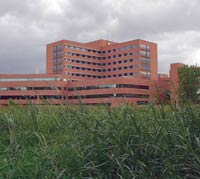view all Case Studies
Hospital Gets a Handle on Emergency-Power System

Methodist Hospital, one of the nation’s top 100 hospitals, wanted to precisely track priority loads to ensure its emergency-power system could handle the extra demands of a power outage and expanding load priorities.
October 2, 2008 -
Power & Communication
Methodist Hospital, one of the nation’s top 100 hospitals, wanted to precisely track priority loads to ensure its emergency-power system could handle the extra demands of a power outage and expanding load priorities.
The Minneapolis hospital upgraded its 26 automatic transfer switches to provide the hospital with real-time load management information to engine generators and power transfer switches. The hospital now knows exactly how much load is on each engine generator and transfer switch every second.
“There’s a big difference between conducting monthly preventive maintenance testing and a real power outage,” says Roger Friesen, senior project manager at Methodist. “During a real outage, people plug into emergency circuits.”
And with 400-500 of those outlets in the 450-bed hospital, there was no way to calculate how much load that added, so Methodist oversized everything in its emergency-power design criteria.
“The last thing we wanted was a transfer switch on overload,” Friesen says.
To better manage the situation, the hospital upgraded its 26 ASCO Services Inc. automatic transfer switches, most of which have bypass-isolation capability.
“We upgraded the transfer switches to monitor loads remotely,” Friesen says.
New controllers and power managers on the transfer switches provide precise information on the four priority loads assigned to the hospital’s three 600-kilowatt (kW) generators and the one 450 kW generator. The upgrade went smoothly with no downtime.
“Now we get a history on outages and know how much additional load is plugged into emergency circuits,” Friesen says. “We can tell whether it’s unloaded or loaded and if it’s loaded, we know the exact amount of load.”
Another benefit of the upgrade is, as the hospital steadily expands, it monitors the amount of load assigned to each engine generator, which guards against overloading. When loads approach a predetermined level, technicians know to add a transfer switch. They no longer need to visit six transfer-switch locations to gather information. It is readily accessible from the hospital’s ASCO monitoring and power-control systems.
A digital display provides real-time data on amperage, voltage and phases and can alert staff when conditions are not within preset limits.
“Step-by-step, user-friendly instructions on the display are a big help,” Friesen says. Reliability is the best attribute of the hospital’s transfer switch and power-control system, he adds.
Next
Read next on FacilitiesNet









